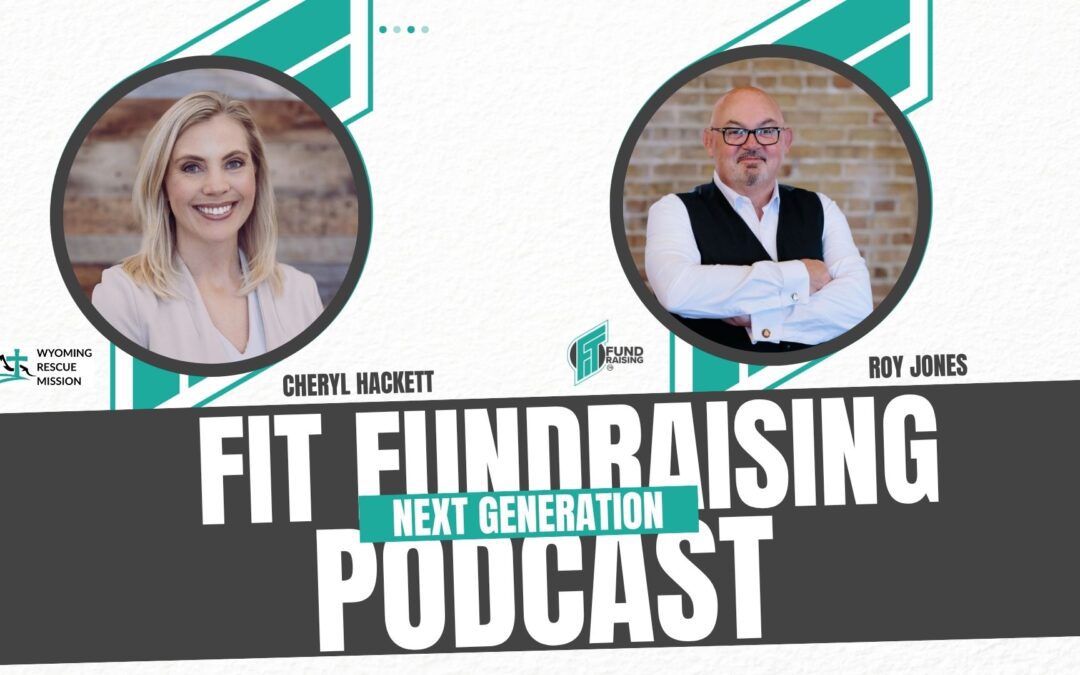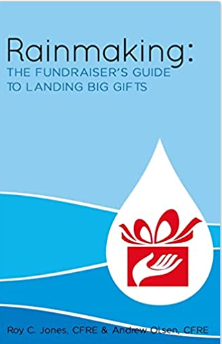Intro
Welcome to the Fit Fundraising podcast, where we bring you game changing fundraising topics direct from our meetings with major donors and nonprofits nationwide. We don’t interview consultants who haven’t met a donor in decades for fundraising stays on the front lines with nonprofit donors and leaders. This podcast is a glimpse into our work with nonprofits as we get on the field of them and successfully modeled fundraising.
Roy Jones: Hello, I’m Roy Jones, and welcome to the Fit Fundraising Podcast. We’re going to have some fun in fundraising today—talking about a really important topic for people who manage direct mail programs, marketing programs, and major gift development. That topic is generational giving. What’s happening? What are the differences between Boomers like me and younger generations? How do we give differently? Which channels do we use—and how is the marketplace shifting in ways that impact our marketing plans? I’m excited about our guest today. She has become a dear friend of mine. She’s deeply involved—and, I have to admit, a great student as well—at City Vision University. Cheryl Hackett is the Director of Development at the Wyoming Rescue Mission. She previously served as the Director of Development for the Boys and Girls Clubs of Central Wyoming, where she oversaw communications, marketing, grants, special events, and fundraising. She was honored with the Boys and Girls Clubs of America Legacy Gift Program Award at their National Conference in Orlando, Florida, in May 2023. Cheryl is truly a leader—recognized for her board engagement, vision, marketing achievements, and legacy giving work. Before moving into nonprofit development, she was a successful news anchor with NBC in Casper, Wyoming. Cheryl, thanks so much for joining us today. We’re honored to have you.
Cheryl Hackett: Thanks, Roy. Thanks for having me.
Roy Jones: I’ve been putting together a series of interviews with what I call rising stars in the rescue mission movement—emerging leaders like you who really have a handle on marketing, fundraising, major gifts, and communications. Before we dive into generational giving, take a minute to tell us about the Wyoming Rescue Mission—what you do there, and what drives your passion.
Cheryl Hackett: Thanks, Roy. At the Wyoming Rescue Mission, our mission statement is: “We restore homeless lives to community independence with the love of Christ.” Our development goal this year is just over $2.8 million, which we raise primarily through direct mail and major gifts. We also have one signature annual event—
Roy Jones: You’ve got to say the name—I love it!
Cheryl Hackett: laughs It’s called Fishing for the Mission. It’s a fly-fishing tournament, coming up next week, so it’s a busy time for us. We’re also in the middle of our May Matching Challenge. Beyond that, we receive support through grants and legacy giving. But what really inspires me—whether it’s writing grants, sharing stories in marketing, or working with donors—is witnessing life transformation. Seeing someone’s hope restored never gets old. It’s such an easy and powerful story to tell.
Roy Jones: People often think homelessness or addiction recovery doesn’t happen in a place like Wyoming.
Cheryl Hackett: It absolutely does—it happens everywhere. We’re the state’s only full-service shelter, so there are a lot of misconceptions. About 60 to 65 percent of the guests we serve are from right here in our own county, another 20 percent are from other parts of the state, and the rest are people just passing through—someone who steps off a bus and needs a place to stay for a few nights. Homelessness happens everywhere, and for many different reasons.
Roy Jones: It’s everywhere. Tell me more about the population you serve—how many people come through your programs?
Cheryl Hackett: Last fiscal year, we served about 3,350 unique individuals. On an average night, we house between 150 and 160 guests across our emergency services, long-term recovery program, and two sober-living houses for men.
Roy Jones: So you provide transitional housing, too.
Cheryl Hackett: We do. Right now, the need is greater for men, but we serve both men and women. About 85 to 90 percent of the guests who complete our year-long recovery program—and move into our sober-living houses—maintain sobriety and employment one year after graduating. Our recovery program is known regionally for its success, and we’ve seen that faith-based recovery programs are consistently more effective than non-faith-based ones. Those are stories I love to share.
Roy Jones: That’s incredible. Let’s jump into our main topic. I’m a Boomer—and you’re a little younger. Are you a Millennial?
Cheryl Hackett: laughs No, I’m Gen X—but I have Millennial kids, and my youngest, born in 2013, is part of the newest generation… I think Gen Alpha?
Roy Jones: That’s right—Gen Z or Gen Alpha. My three sons are in their forties, and I’ve got seven grandkids ranging from fourteen down to two. So yes—lots of generations under one roof. Tell me what you’re seeing in giving trends at the Wyoming Rescue Mission. Are younger people beginning to participate more, or are Boomers still the core group?
Cheryl Hackett: It’s exciting to see both. We still have very loyal Boomer donors—many who’ve been with us since the Mission’s founding in 1978, when it began as a coalition of churches serving the poor. They’re faithful, engaged, and generous, but they’re also practical and frugal. Some ask to be removed from direct mail, saying, “I’ll still give, but I’d rather do it another way.” Many still write checks and mail them, but increasingly, we see Boomers embracing technology—getting a letter in the mail and then giving online.
Roy Jones: So you’re seeing people read the mail but donate digitally?
Cheryl Hackett: Exactly. And it’s hard to know which came first—did they give online because they received the mail, or were they influenced by our digital campaigns that mirror our direct mail? We use a multichannel approach—direct mail supported by email and digital. People can choose the most convenient way to give. For example, I recently talked to a Boomer who asked, “Can I give online?”—and of course, the answer is yes! As a Gen Xer myself, life is busy—working full time, being a grad student at City Vision University, and raising five kids. So if you send me something in the mail, it might sit in the pile—but it still prompts me to give online.
Roy Jones: Mail has shifted from being the converter—where people filled out the reply card and mailed a check—to being more of a driver. People get the envelope and then go online to give.
Cheryl Hackett: Exactly. That’s why we make giving as easy as possible. In our emails, we include multiple “Give Now” buttons and links, clearly labeled for donors who might not be as tech-savvy. We’re also using text-to-give and SMS messaging, and it’s been exciting to see an uptick in activity when we send a coordinated email and text. Because of tracking, we can see when someone receives an email, clicks through, gives, and automatically receives a thank-you message. We’re also experimenting with voicemail-drop campaigns—lots of creative strategies.
Roy Jones: I love that. How are you using texting specifically? Is it for emergencies or general appeals?
Cheryl Hackett: Mostly for urgent messages. For example, right now we’re wrapping up a matching challenge, and I’d like to use text-to-give for those reminders. The nice thing about texting is you can segment who receives it. It’s not one-size-fits-all—you have to be sensitive. It might offend a Boomer or Gen Xer who gave a large gift to suddenly get a text appeal. But for lapsed or mid-level donors, or younger givers, it can be an easy and effective way to capture quick $20 or $50 gifts.
Roy Jones: Right—perfect as a win-back tool. I’ve seen nonprofits go to extremes—some abandon mail completely for digital, thinking it’s cheaper. Many of those don’t survive. Others refuse to adopt new media and get stuck. What’s the right balance?
Cheryl Hackett: To reach all generations effectively, you have to use a mix. Direct mail still lends credibility. For example, we once sent a voicemail drop to a millennial donor—it came from a local area code, but he thought it wasn’t legitimate because it didn’t match our main number. That’s why mail still matters. It feels real. At the same time, digital campaigns allow us to reach people at lower cost. We’re experimenting with OTT video ads (that’s streaming-platform advertising) because more people are watching news and sports on streaming services. We produced a short video ad in-house at low cost, then sent it to local stations that offer nonprofit discounts. That helps us stretch our budget while maintaining local presence. We still advertise in our local newspaper during key campaigns, because our 60-, 70-, and 80-year-old donors still read it daily. They may not check email or social media, but they notice that paper.
Roy Jones: That’s such a great reminder. If listeners want to connect with you or learn more about the Wyoming Rescue Mission, how can they reach you?
Cheryl Hackett: The easiest way is through our website, wyomission.org. I’m also on Facebook, Instagram, and LinkedIn—but not on TikTok yet! I’d be happy to connect.
Roy Jones: Thank you so much, Cheryl. I really appreciate you joining us today. And to everyone listening—thanks for being part of the Fit Fundraising Podcast. If you need fundraising support, visit fitfundraising.com. I built this company by helping organizations raise money—often for free at first—and many of those went on to become long-term partners. If we can help you strengthen your fundraising, reach out through the site. We’d love to talk with you. See you next time.
Thanks so much for listening to the FIT Fundraising Podcast. Please make sure to subscribe on your favorite podcast app so you’ll be notified of future episodes. And as always, make sure to visit fitfundraising.com to get your fundraising program into shape.
- Follow Us: Facebook | LinkedIn
- Subscribe to the Fit Fundraising Podcast: Apple Podcasts | Spotify
- Visit our Website at fitfundraising.com


